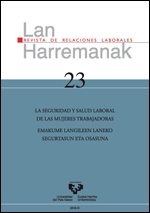El derecho del padre a disfrutar del permiso por lactancia cuando la madre es una trabajadora autónoma (A propósito de la STJUE de 30 de septiembre de 2010, Asunto C-104/09; Roca Álvarez)
##plugins.themes.bootstrap3.article.main##
##plugins.themes.bootstrap3.article.sidebar##
Abstract
The aim of this jurisprudential comment is to explain the interpretation given by the European Court of Justice (EUCJ) in Luxembourg with regard to section 37.4 ET governing breastfeeding leave which —as we know— enables this remunerated right to be exercised pursuant to the aforementioned provision provided that the mother is fully employed. In this way, the request for fathers who preferred to enjoy this right while the mother was a worker affiliated to the Special Self-Employed Workers' Scheme (RETA) was being denied and rejected. Following this intervention by the EUCJ, fathers will now be able to enjoy this right by their being holders of the same right to breastfeeding leave.
How to Cite
##plugins.themes.bootstrap3.article.details##
Authors who publish in the journal "Lan Harremanak" do so in agreement with the following terms:
1. Authors retain the copyright of their papers. while ceding to the journal "Lan Harremanak" the right to the first publication of their article.
2. The publisher UPV/EHU Press is a joint copyright holder, in order to protect the legitimate use of the published paper and compliance with CC terms.
3. Published papers are subject to a Creative Commons CC-BY license (unless stated otherwise) which permits third parties to share the paper, on the condition that the author and source are specified when material is reproduced.
4. Authors can enter into other non-exclusive license agreements regarding the published version of their work (e.g. depositing it in an institutional repository or re-publishing it as a monographic volume), providing the author and source are given appropriate credit.
5. Dissemination of submitted articles via Internet is both allowed and recommended (e.g. in institutional repositories and/or on the researcher's web page), both before and during the process of submission, since this can lead to interesting dialogues and also increase citations to the eventual publication.

